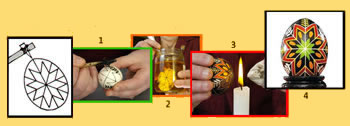| Q1. |
I would like to learn how to make Pysanky. What supplies do I need to get started?
We suggest beginners get started by purchasing a "Basic Kit" and expanding from there. The Basic Kit contains all the supplies you need to make Pysanky in the traditional way:
- the kistka is sturdy and will last indefinitely if used properly
- the dyes can be used from year to year if stored properly to avoid evaporation (simply add a tablespoon of vinegar every couple of months to rejuvenate them)
- there is enough beeswax to make many Pysanky of a basic design
- the cleaning wire is a useful tool that removes unwanted debris from the funnel of the kistka
- all kits include step-by-step instructions, colored diagrams, helpful hints, important information, a description of the history and tradition of Pysanky, symbols and their
meanings and sample designs
TIP: if you're making Pysanky with your friends or family, with kids for example, rather than purchase 2 Basic Kits, just buy one, add a kistka for each additional person
and easily share all the other things!
|
| |
 |
| Q2. |
I see that the Basic Kit is really affordable. Is there anything else I need?
If you want to expand the Basic Kit, we suggest that you purchase any of the following additional items, depending on your budget (all are optional, of course!)
- kistka / candle holder
- drying board
- books
- extra kistka (start with size fine, then heavy)
- extra dye colors (make sure you have enough jars)
- extra beeswax
|
| |
 |
| Q3. |
What books do you suggest for beginners?
In addition to the excellent pamphlet included with all the kits we also recommend the following reading for beginners: |
| |
| Excellent source of useful and timely information on Pysanky: |
EGGS-aminer published by Bluenose Press
|
| For children aged 2 to 12: |
Pysanky on Paper: An Activity Book for Children
My First Pysanka : Symbols my Baba Taught Me
|
| Excellent source of information on technique: |
Ukrainian Egg Design - Book 1 (1984)
Ukrainian Egg Design - Book 2 (1986)
Ukrainian Egg Design - Book 3 (1995)
Ukrainian Egg Design - Book 4
Ukrainian Egg Design - Booko 6
|
| Excellent source of information on tradition and history: |
Eggs Beautiful (1975)
Ukrainian Easter Eggs & How We Make Them (1979)
|
|
| |
 |
| Q4. |
What is the drying board used for?
The drying board is a sturdy wooden board that has stainless steel nails arranged in tripod configurations to hold 15 eggs at a time. It is:
- essential for removing beeswax using the oven method
- provides a safe place for drying your emptied eggs
- protects eggshells while they are draining
- convenient place for resting your eggs while decorating
|
| |
 |
| Q5. |
Do I need to buy new dyes every year?
No, eggshell dyes are aniline, non-edible and come in a powdered form. They are prepared with water and vinegar (all except the orange dye which requires no vinegar!). The vinegar
acts as a setting agent and allows the color to adhere to the eggshell. Once prepared, the dyes will last indefinitely. Two enemies are:
- evaporation - therefore, store dyes in air-tight jars
- bacteria from eggs contaminating the dyes - when this happens the dyes become cloudy and show evidence of bacteria growth, but can still be used successfully. Simply strain
the dye through cheesecloth, bring to a boil, and add 1 tablespoon white vinegar. From time to time (ie. every couple of weeks) add 1 tablespoon of white vinegar to the dyes
to rejuvenate their dyeing power
|
| |
 |
| Q6. |
What do your logo tee-shirts look like?
Our Tee-Shirts are of excellent quality (Hanes, made in USA), 100% cotton, short-sleeved and generous in length. They are teal-green in color Their design is black line-art. The
design is a 9"x13" rectangle that contains a kistka resting atop an egg that has a few wax lines written on it in the motif of a star rosette. Under the rectangle are the words "Baba's
Beeswax". |
| |
 |
| Q7. |
What are templates and how are they used?
The construction of our templates is somewhat between heavy paper and light cardboard. There are 16 pysanka templates in a package ranging from 1/4" to 4-7/8". They are designed
to divide all sizes of eggs into equal parts of 2, 4, 6 or 8 or for circles. |
| |
 |
| Q8. |
The only eggs available here are brown! Although it works ok (gives the final egg sort of an "antique" look), we would like to have some white in
the design on occasion. Only the lighter colors seem to be affected. Any suggestions?
The only way to get "white" in your design is to start with white eggs. Brown eggs produce very nice results, don't they? |
| |
 |
| Q9. |
Why do my dyes not go on smoothly, but rather in a blotchy and streaked manner?
This sounds like it's because of the egg surface itself and not the dyes. Every eggshell reacts differently to the dyes and there is no guarantee that the color will come out "smooth"
and "consistent" |
| |
 |


 Your Questions about our site
Your Questions about our site